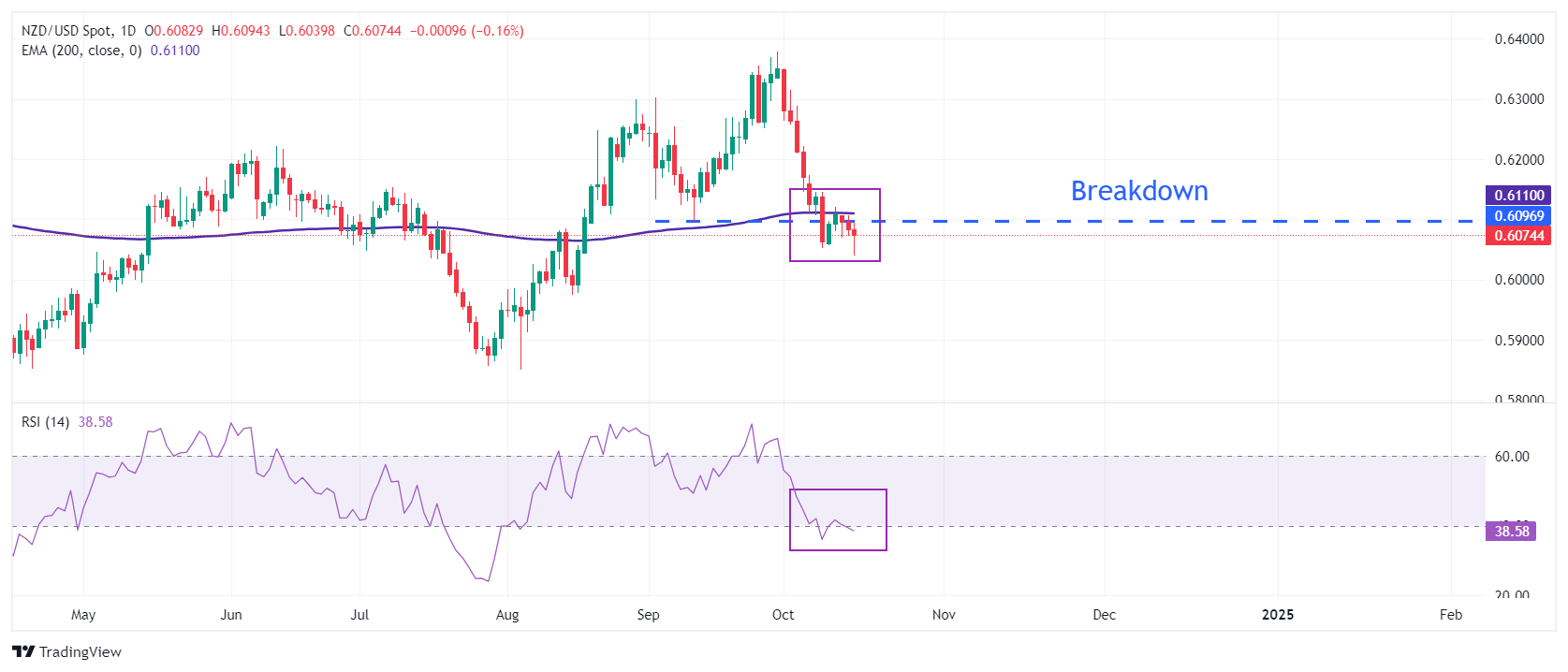- Analytics
- News and Tools
- Market News
- NZD/USD Price Forecast: Finds temporary support near 0.6040
NZD/USD Price Forecast: Finds temporary support near 0.6040
- NZD/USD sees more downside as soft NZ inflation has prompted RBNZ dovish bets.
- The US Dollar refreshes a two-month high as the Fed is expected to cut interest rates gradually.
- NZD/USD declines below the 200-day EMA.
The NZD/USD pair finds some buying interest after posting a fresh almost two-month low near 0.6040 on Wednesday. The near-term outlook of the Kiwi pair remains vulnerable as the New Zealand (NZ) Q3 Consumer Price Index (CPI) decelerated expectedly.
Annualized CPI rose by 2.2%, as expected, slower than 3.3% in the similar quarter of the previous year. Quarter-on-quarter inflation grew at a slower pace of 0.6% from the estimates of 0.7%, However, the pace was higher than 0.4% in the second quarter of the year.
Soft inflation data has prompted expectations that the Reserve Bank of New Zealand (RBNZ) could cut its Official Cash Rate (OCR) with a larger-than-usual size of 50 basis points (bps) for the second time in a row.
Meanwhile, the US Dollar (USD) posts a fresh two-month high as traders have priced out expectations that the Federal Reserve (Fed) would continue with a sizeable interest rate cut in November. According to the CME FedWatch tool, the Fed will cut its key borrowing rates by 25 bps in each of the two meetings remaining this year.
NZD/USD weakens after breaking below the horizontal support plotted from September 11 low of 0.6100 on a daily timeframe. The overall trend of the Kiwi pair has become bearish as it has formed a lower swing low. The asset is also trading below the 200-day Exponential Moving Average (EMA), which trades around 0.6100.
The 14-day Relative Strength Index (RSI) slides below 40.00, suggesting that a bearish momentum has been triggered.
More downside is highly likely towards the psychological support of 0.6000 and the August 15 low of 0.5974.
On the flip side, a reversal move above October 8 high of 0.6146 will drive the asset towards the 50-day EMA at 0.6173 and October 4 high near 0.6220.
NZD/USD daily chart
New Zealand Dollar FAQs
The New Zealand Dollar (NZD), also known as the Kiwi, is a well-known traded currency among investors. Its value is broadly determined by the health of the New Zealand economy and the country’s central bank policy. Still, there are some unique particularities that also can make NZD move. The performance of the Chinese economy tends to move the Kiwi because China is New Zealand’s biggest trading partner. Bad news for the Chinese economy likely means less New Zealand exports to the country, hitting the economy and thus its currency. Another factor moving NZD is dairy prices as the dairy industry is New Zealand’s main export. High dairy prices boost export income, contributing positively to the economy and thus to the NZD.
The Reserve Bank of New Zealand (RBNZ) aims to achieve and maintain an inflation rate between 1% and 3% over the medium term, with a focus to keep it near the 2% mid-point. To this end, the bank sets an appropriate level of interest rates. When inflation is too high, the RBNZ will increase interest rates to cool the economy, but the move will also make bond yields higher, increasing investors’ appeal to invest in the country and thus boosting NZD. On the contrary, lower interest rates tend to weaken NZD. The so-called rate differential, or how rates in New Zealand are or are expected to be compared to the ones set by the US Federal Reserve, can also play a key role in moving the NZD/USD pair.
Macroeconomic data releases in New Zealand are key to assess the state of the economy and can impact the New Zealand Dollar’s (NZD) valuation. A strong economy, based on high economic growth, low unemployment and high confidence is good for NZD. High economic growth attracts foreign investment and may encourage the Reserve Bank of New Zealand to increase interest rates, if this economic strength comes together with elevated inflation. Conversely, if economic data is weak, NZD is likely to depreciate.
The New Zealand Dollar (NZD) tends to strengthen during risk-on periods, or when investors perceive that broader market risks are low and are optimistic about growth. This tends to lead to a more favorable outlook for commodities and so-called ‘commodity currencies’ such as the Kiwi. Conversely, NZD tends to weaken at times of market turbulence or economic uncertainty as investors tend to sell higher-risk assets and flee to the more-stable safe havens.
© 2000-2024. All rights reserved.
This site is managed by Teletrade D.J. LLC 2351 LLC 2022 (Euro House, Richmond Hill Road, Kingstown, VC0100, St. Vincent and the Grenadines).
The information on this website is for informational purposes only and does not constitute any investment advice.
The company does not serve or provide services to customers who are residents of the US, Canada, Iran, The Democratic People's Republic of Korea, Yemen and FATF blacklisted countries.
Making transactions on financial markets with marginal financial instruments opens up wide possibilities and allows investors who are willing to take risks to earn high profits, carrying a potentially high risk of losses at the same time. Therefore you should responsibly approach the issue of choosing the appropriate investment strategy, taking the available resources into account, before starting trading.
Use of the information: full or partial use of materials from this website must always be referenced to TeleTrade as the source of information. Use of the materials on the Internet must be accompanied by a hyperlink to teletrade.org. Automatic import of materials and information from this website is prohibited.
Please contact our PR department if you have any questions or need assistance at pr@teletrade.global.
















